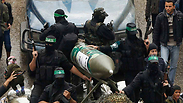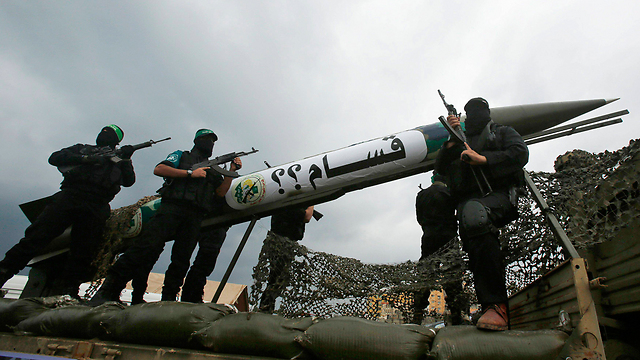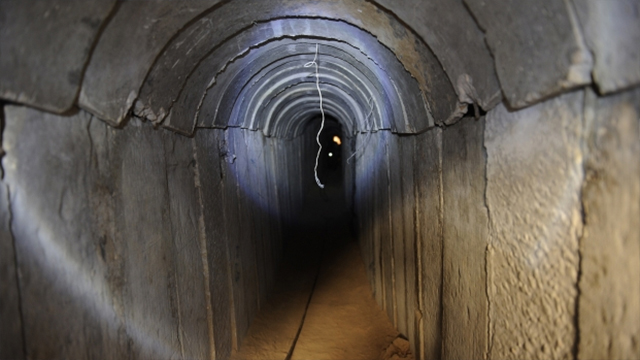
'Hamas close to restoring pre-Protective Edge rocket capabilities'
One year later, IDF Southern Command official says Gaza terror group close to restoring stock of short-range rockets, but has yet to recover amount of rockets capable of reaching Tel Aviv, Jerusalem.
Exactly one year ago, on July 8, 2014, the IDF launched Operation Protective Edge in the Gaza Strip to stop incessant rocket fire aimed at southern Israel and to destroy Hamas' network of underground tunnels dug under the Israel-Gaza border to facilitate terror attacks against Israeli citizens.
The IDF's Southern Command said last summer's operation in Gaza was the biggest and most significant Israel has ever fought against the Palestinians in general and in the Strip in particular.
At the end of Operation Protective Edge, Army Intelligence estimated that over two-thirds of Hamas' rockets were destroyed in the fighting. A source in the Southern Command said Tuesday that Hamas has yet to restore its rockets stock to what it was before the war, but that it was getting closer to doing so.
"Hamas is getting closer to finishing restoring its stock of mortar shells and short-range rockets," the official said. "They don't yet have the amount of medium- and long-range rockets (that can reach Tel Aviv, Jerusalem, and further north) it had. Hamas will not give up the ability to fire rockets deep into Israel in the next war, because to them, a routine of sirens and emergency situation in Tel Aviv is an achievement."
The source said Hamas has also started digging tunnels inside the Strip again, but, "Hamas is not re-digging the tunnels we destroyed - digging such cross-border tunnels could take years. Hamas is nowhere near the border fence."
The official further said that in a few weeks, a new system the IDF put in place to detect tunnels and digging in a certain area of the border with Gaza will become operational. This system, he said, will work alongside another new defensive system used against the tunnels.
"We're on the verge of a breakthrough against the tunnels," he asserted.
The IDF considers the road Hamas has been paving 300 meters from the border with Israel an advantage, the official said, as it allows the troops to see Hamas' fighters. "Using this road, we can avoid confrontations, clashes and infiltration attempts into Israel," he said.
The source asserted that Israel's aid in rehabilitating the Gaza Strip can positively affect the security situation.
Noting the hundreds of trucks carrying goods that Israel allows into the Strip every day, he said, "We can have a more substantial rehabilitative process, which could undermine any claims of a siege and a blockade that in my opinion doesn't exist, and raise the price of loss for the Gaza people. We recommended allowing more goods and allowing Palestinians to work in Israel after they pass security checks. The longer the economic problems in Gaza continue, the bigger the potential of friction, regardless of deterrence."
The official went on to say that the IDF "is in a race against Hamas who will learn the lessons of Protective Edge faster."
The Southern Command has completed its strategic plans in the case of another war against Hamas and will present them to the political echelons soon. The army believes the next confrontation should be shorter, unlike Protective Edge which lasted 50 days.
He also expressed concern of reliable polls showing that 10-15 percent of the Palestinians in Gaza support the Islamic State, twice as much than the average in Arab countries. He estimated there are now 500-1,000 ISIS terrorists in the Strip.
"Every successful ISIS operation recruits more militants, most of them local," he said, noting that ISIS focuses its activity in Sinai near the Gaza Strip because it is easier for the organization's militants to hide in populated areas.
Regarding the threat of rockets from Sinai, the official said he was more concerned of car bombs or attacks on Israel-Egypt border crossings than rockets. "We need to do everything to protect the Egyptian sovereignty in Sinai, but we are prepared for a situation in which the fighting there won't lead to good results. Our defenses in that area have changed recently," he said.
Footage from Maj. Benaya Sarel's go-pro cam
Several days before being killed in battle in Rafah, a commander in Givati's reconnaissance platoon, Maj. Benaya Sarel, took part in a mission in the Gaza Strip. A year later, the IDF's Spokesman released a video from Maj. Sarel's go-pro camera, documenting the mission.
The commander and his troops are seen moving towards terror targets in Hirbat-Hiza, and are later seen clearing a Hamas structure.
A few days after this footage was filmed, on August 1, 2014, Sarel, Staff Sergeant Liel Gidoni and Sec.-Lt. Hadar Goldin were killed when a Hamas cell ambushed their unit in Rafah during a humanitarian ceasefire in the fighting last summer.
Additional recordings released by the IDF Spokesman document the voices heard over army communications on what has been dubbed "Rafah's Black Friday," some six months after Ynet released a series of similar recordings.
The new recordings include communications between the Givati Brigade commander at the time, Col. Vinter, and the commander of Givati's reconnaissance platoon Lieutenant Colonel Eli Geno. These communications happened in the hours after the deadly Hamas ambush. They are heard announcing the Hannibal Directive.
An IDF investigation of the incident found that the orders given that day to Givati recon troops to search for tunnels in the Rafah area during a ceasefire limited their abilities to respond and act and caused confusion among the troops in the battle field.
The investigation also found that the Hamas cell took advantage of that and was able to surprise Sarel's team, managing to return to the tunnels within less than a minute, leaving one killed terrorist behind.
The Military Advocate General has yet to decide whether to open a criminal investigation into the incident.













